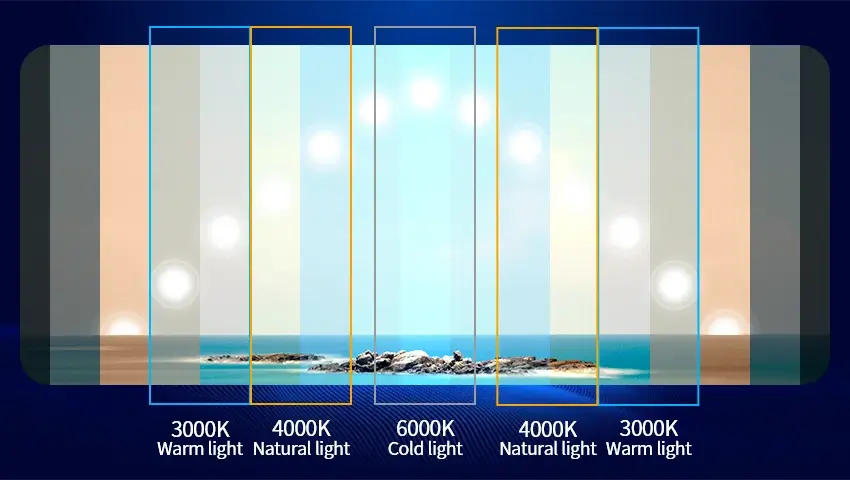Choosing between warm light and cool light can significantly affect the ambiance and functionality of a space. Each type of light has distinct characteristics and ideal use cases. Let’s explore the differences between warm and cool light and when you might prefer one over the other.
Contents
The Basics of Color Temperature
Light color is described by its color temperature, measured in Kelvin (K). The concept originates from the physical property of “black body” radiation—when a black body is heated, it glows in colors that change as the temperature rises: red, yellow, and finally white. This chromatic shift forms the basis of our perception of color temperature in lighting.
- Warm Light: Characterized by a color temperature under 3000 K, emitting red, orange, or yellow hues, warm light creates a cozy and tranquil atmosphere.
- Cool Light: Typically has a color temperature exceeding 4000 K, producing a bluish-white glow reminiscent of daylight or an overcast sky.
What Is Warm Light?
Warm light resembles the comforting glow of a setting sun and is often associated with cozy settings. Common sources include:
- Candlelight
- Halogen lamps
- Yellow LED lights
Pros of Warm Light:
- Relaxing Ambiance: Ideal for living rooms and bedrooms, creating a cozy environment.
- Reduced Eye Strain: Easier on the eyes for prolonged use.
- Better Sleep: Stimulates melatonin production, fostering healthy sleep patterns.
- Aesthetic Appeal: Enhances the intimacy of a space.
Cons of Warm Light:
- Poor Color Rendering: May not accurately represent colors, making it less suitable for precision tasks.
- Limited Visibility: Can be inadequate for detail-oriented activities like reading or crafting.
- Perceived Lack of Brightness: Often appears dimmer compared to cool light.
What Is Cool Light?
Cool light emits a brighter, bluish-white glow and is commonly found in:
- White LED lights
- Neon signs
Pros of Cool Light:
- Improved Concentration: Enhances focus and productivity, making it suitable for workspaces.
- Enhanced Color Accuracy: Provides better color rendering for tasks requiring precision.
- Increased Visibility: Ideal for detail-oriented tasks due to its brightness.
- Mood Stimulation: Creates an energetic environment.
Cons of Cool Light:
- Potential Eye Strain: Prolonged exposure may lead to discomfort.
- Sleep Disruption: Can interfere with melatonin production, disrupting sleep.
- Impersonal Atmosphere: May feel cold or sterile if not balanced with warmer tones.
Warm Light vs. Cool Light: Key Differences
The primary distinction lies in their color temperature and appearance. Here’s a breakdown:
| Aspect | Warm Light | Cool Light |
|---|---|---|
| Color Temperature | < 3000K (red, orange, yellow) | > 4000K (blue, white) |
| Mood and Atmosphere | Cozy, calming | Alert, energetic |
| Eye Comfort | Easier on the eyes | May cause eye strain |
| Ideal for | Living rooms, bedrooms | Offices, kitchens |
| Task Suitability | Relaxing activities | Detail-oriented tasks |
| Interior Design Compatibility | Traditional, rustic | Modern, minimalist |
| Energy Efficiency | Slightly less efficient | Slightly more efficient |
| Impact on Circadian Rhythm | Less likely to disrupt sleep | May disrupt sleep if used at night |
| Color Rendering Index (CRI) | May render colors inaccurately | Generally represents colors accurately |
Best Light Color Recommended for Your Home
Selecting the right light color varies based on each room’s purpose, decor, and desired ambiance. Here’s how to approach lighting for specific areas:
- Living Room: Warm light fosters comfort and enhances decor, ideal for relaxation and socializing.
- Kitchen: Cool light aids in task completion, though a mix of both can create a versatile environment.
- Bedroom: Warm light is best for relaxation, promoting better sleep quality.
- Bathroom: Depending on the design, cool light is great for grooming tasks, while warm light can enhance a soothing atmosphere.
- Home Office: Cool light improves focus and productivity, fitting modern workspace aesthetics.
- Garden: Warm light creates a welcoming outdoor ambiance for evening gatherings.
Bonus Tips: How to Choose the Best LED Light
- Determine the Room’s Function: Match light type with room purpose.
- Pay Attention to CRI: Higher CRI for color accuracy is essential in certain spaces.
- Consider Brightness (Lumens): Choose based on lumens for desired brightness.
- Check Energy Efficiency: Look for Energy Star ratings.
- Dimmability: Opt for dimmable LEDs for versatility.
- Longevity and Warranty: Longer warranties often indicate reliability.
- Consider Smart Lighting Options: Explore smart features for convenience.
- Be Mindful of Fixture Compatibility: Ensure bulb compatibility with fixtures.
FAQs
1. Can I mix warm and cool light in the same space?
Yes, mixing light color temperatures can create a balanced and dynamic environment. For example, a kitchen might use cool light for tasks like cooking and warm light for dining.
2. How do I know if my current lighting is too warm or too cool?
Consider the activities that take place in the room and how the lighting affects your comfort and productivity. If you feel lethargic in a brightly lit room, it might be too cool; if you strain your eyes, it might be too warm.
3. Are there health risks associated with certain types of light?
Excessive exposure to cool light, especially blue light, can disrupt sleep patterns and potentially contribute to eye strain. It’s important to maintain a balance and consider the timing of light exposure.
4. Is Warm or Cool Light Better for the Eyes?
The ideal lighting depends on the task and individual sensitivity. Generally, warm light is easier on the eyes.
5. What Type of Light Is Best for Relaxing?
Warm light is preferred for relaxation due to its soothing qualities.
6. Is Cool Light More Energy-Efficient than Warm Light?
Yes, cool light is usually more energy-efficient.
7. Why Does Warm Light Look Better?
Warm light mimics natural evening light, creating a comforting environment and casting flattering shadows.
8. Should I Have Warm or Cool Light at Night?
Warm light is recommended for nighttime use in bedrooms, while cool light may be better for outdoor security.
Conclusion
Both warm and cool light provide unique atmospheres and functionalities. Warm light creates a cozy environment, while cool light inspires clarity and focus. Your ultimate choice should align with the room’s purpose and your personal preferences.





